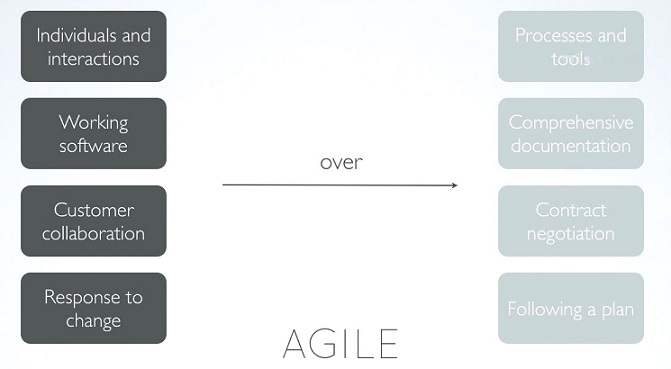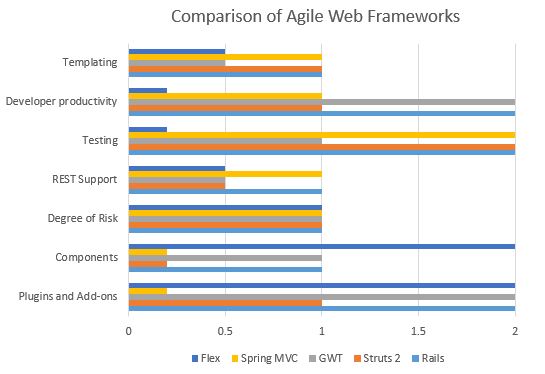CSC/ECE 517 Fall 2013/ch1 1w39 as: Difference between revisions
No edit summary |
No edit summary |
||
| Line 106: | Line 106: | ||
:* Precompiled files can also be attached. | :* Precompiled files can also be attached. | ||
=References= | ==''Comparison of Rails with other Agile Web Frameworks''== | ||
[[File:Stats.JPG|25 px|upright=0.85|center|frame|alt=Puzzle globe logo| Fig 3:Comparison of Agile Web Frameworks]] | |||
==References== | |||
<references/> | <references/> | ||
Revision as of 05:18, 7 October 2013
This article focuses on how Rails enables ‘’’agile development practices’ and the characteristics of Rails that support specific agile methodologies.
Agile development
What is Agile development?
Agile development<ref> http://en.wikipedia.org/wiki/Agile_software_development </ref> is a methodology where requirements and solutions are developed based on iterative and incremental development <ref>http://en.wikipedia.org/wiki/Iterative_and_incremental_development</ref> through collaboration between self-organizing, cross-functional teams. Using agile development methodology, a high quality software can be developed by programmers in a minimal amount of time.
Some of the process under agile development includes adaptive planning, evolutionary development and delivery, a time-boxed iterative approach, and encourages rapid and flexible response to change. It is a conceptual framework that promotes foreseen interactions throughout the development cycle.
Why do we need Agile development?
- Visibility through active customer involvement
- Flexibility/Agility - ability to accept changes
- Quality - testing integrated throughout the lifecycle
- Speedy delivery
- Customer satisfaction - feeling of a right product
Characteristics of agile development
- Break tasks into small increments with minimal planning and do not directly involve long-term planning.
- Short time frame iterations that last from one to four weeks. Each iteration involves a cross functional team working in all functions. Multiple iterations might be required to release a product or new features.
- Each agile team will contain a customer representative. This person is appointed by stakeholders to act on their behalf. At the end of each iteration, stakeholders and the customer representative review progress and re-evaluate priorities ensuring alignment with customer needs and company goals.
- Daily status meetings or "stand-ups".
- Specific tools and techniques, such as continuous integration, automated or xUnit test, pair programming, test-driven development, design patterns, domain-driven design, code refactoring and other techniques are often used to improve quality and enhance project agility.
- Light Agile Development (LAD) is a flavor of agile methodology that applies hand picked techniques from the wider range of agile practices to suit different companies, development teams, situations and environments.

Principles of agile development
- Iterative Development: Iterative development allows the clients to direct the development process in order to get the software features they want. Working software is delivered to the client at regular, short intervals. Client feedback is used to make changes to the software specifications at any stage in the development.
- Open Collaboration: Open, unrestricted communication between programmers and clients are driving force behind agile development. The programming team must work closely with the customer and also communicate freely with each other. Face to face communication is preferred over specification documents, so working in an open office with no cubicles is ideal.
- Adaptability: In agile development, changes to the software specifications are welcome even in late stages of development. Principles like Don't Repeat Yourself (DRY) are used to facilitate this. Customers gets hands-on experience with the development of the product, hence they will be able to better communicate their needs. Hence, changes in the market or company structure can be accomodated in the software at any time of the development cycle.
Some well known agile development methods
Well-known agile software development methods include:
- Acceptance Test Driven Development (ATDD)
- Agile Modeling
- Agile Unified Process (AUP)
- Continuous integration (CI)
- Dynamic Systems Development Method (DSDM)
- Extreme Programming (XP)
- Feature Driven Development (FDD)
- Lean software development
- Scrum
- Story-driven modeling
- Software Development Rhythm
Why Use Ruby on Rails for Agile?
Speedy and Effective Development
- Rails provides a very fast mode to write code in a multitude of languages such as html, javascript, ruby, css, etc that are used to build a web-application by providing preconfigured environments and wire-framed models.
- Without investing much resources, it can build business models and deliver functionalities, giving scope to customers to innovate and input faster.
Open Source
- The frequently used features and common functionalities can be implemented easily as they are available as Ruby gems.
- Provides developers the flexibility to customize and thus encouraging them to make large contributions.
Convention over Configuration
- By following this design paradigm, rails makes it simple for the developer as he need not specify or waste time to decide conventional aspects.
- On agreeing to implement simple and common things in a single way, it makes it easy for any new developer to work immediately on an existing project.
- This also rules out the need for explicit configuration ( except for unconventional/ customizable aspects).
How Rails supports Agile Methodologies
Generators and Scaffolds
- The command “rails generate” uses templates to create models, controllers, views, databases, etc which helps to setup a test application.
- The scaffolding can be easily done to deploy any basic web -application, and developers can extend them to implement their functionalities. This overcomes the initial hurdle.
Ready Setup for Multi-environment
- Rails application provides development, production and testing environments with built-in configurations setup and thus is a huge time saver for an application which is required to be deployed in multiple environments.
- The built-in rails web-server has the development environment as the default environment.
- Simple deployment allows developers to have face-face client meetings and thus make instantaneous changes based on the client requirements.
Test-Driven Development
- Built in mocking and stubbing frameworks are available which assists “how to write code”. This follows a red, green and refactor which is an important aspect of agile development.
- RSpec is one of the famous testing framework tools used with rails.
- Other testing tools can also be swapped in.
Don’t Repeat Yourself (DRY)
- Repeated code is written in helpers and libraries, making a single destination and thus updations become simpler by updating at just one place.
- Partials are a way of rendering repeated HTML code. Rails understand a file which starts with an underscore, say, _partial.html as a partial to be included in the shared html file which renders it.
Dependency Management
- Rails acts more than a web framework by providing the necessary utility and support tools and adding dependencies to individual projects in a jiffy using the “bundler”.
- This bundler installs all the relevant gem files and also can be updated when more dependencies are added. No need to search for packages or jars.
Easy Migration
- Rails helps you to keep easy track of database changes with the help of Migration Objects. It gives the flexibility to rollback and update.
- It also allows you to maintain various versions of database for the multi-environment. On running rake db::migrate, the desired database is migrated and deployed with the working rails server.
- New technologies such as Coffeescript can also be easily embedded by installing the relevant gems thus adapting to the changing technology.
Assets Pipeline
- The assets pipeline is a new feature embedded in rails ( which is now extracted into sprockets-rails gem), concatenates and compresses javascript and css files.
- This renders a web page with reduced number of requests from the browser as files are grouped and whitespaces are trimmed.
- Precompiled files can also be attached.
Comparison of Rails with other Agile Web Frameworks

References
<references/>